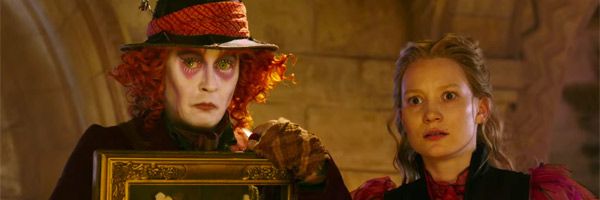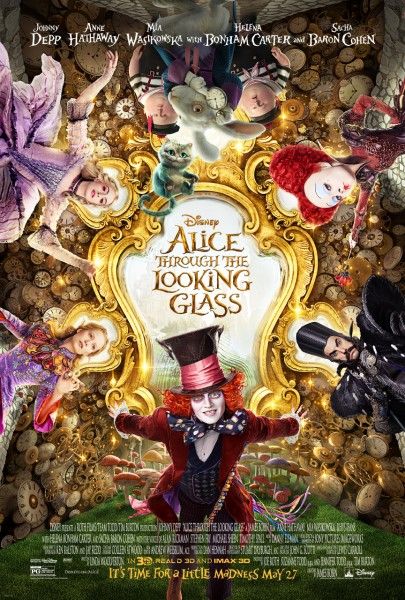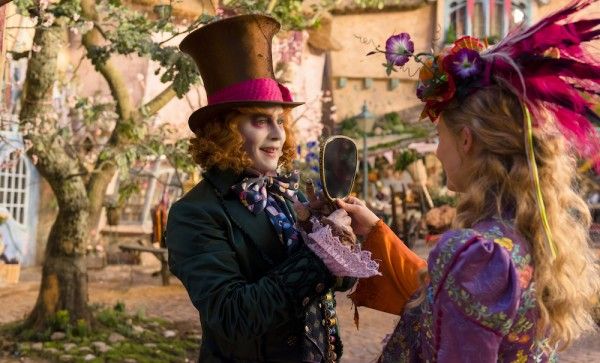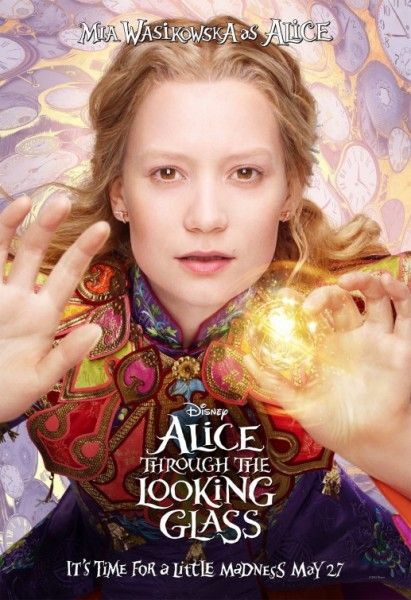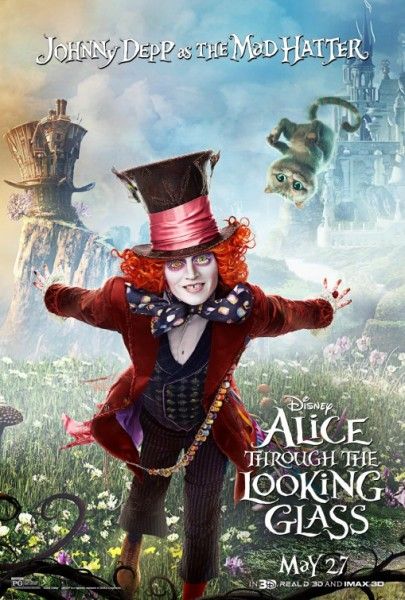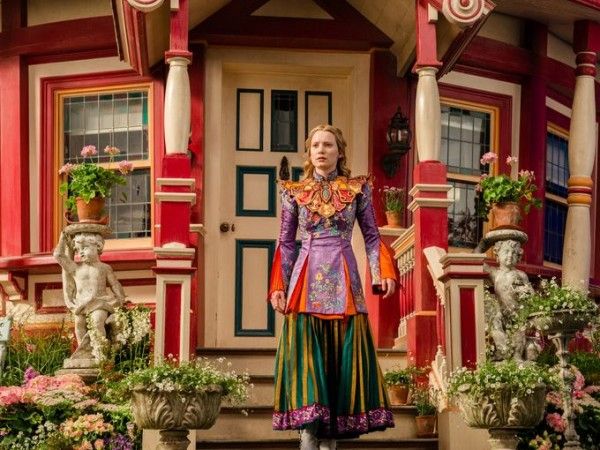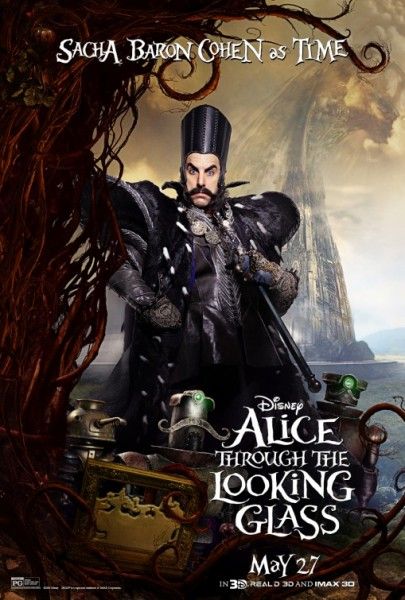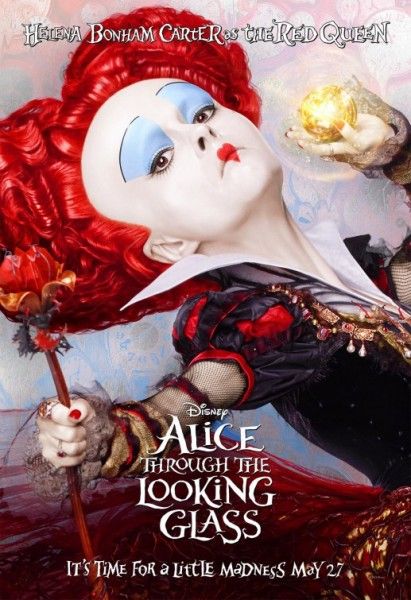Collider was recently invited to an early press day for Disney’s upcoming Alice Through the Looking Glass, directed by James Bobin, and to chat with one of the film’s producers, Suzanne Todd. In the exciting new fantasy adventure based on Lewis Carroll’s popular stories, Alice (Mia Wasikowska) returns to the magical realm of Underland and travels back in time to save the Mad Hatter (Johnny Depp). The sequel to 2010’s Alice in Wonderland reunites the cast and memorable characters from the first film and introduces several new characters: Zanik Hightopp (Rhys Ifans), the Mad Hatter’s father, and Time himself (Sacha Baron Cohen), a time-traveling villain who is part human, part clock.
At our roundtable interview, Todd talked about the unexpected level of success of the first film, the six-year process to bring the sequel to the screen, Tim Burton’s involvement, the challenge of staying true to what they loved about the first movie while expanding on it, the importance of creating a new story that was resonant, felt authentic, and had complex and interesting plotlines, how screenwriter Linda Woolverton crafted a strong female character that’s unlike those in other movies, the epic opening and closing action sequences brought to life by visual effects supervisor Ken Ralston, the spectacular new costumes designed by Colleen Atwood, and story ideas for a possible third Alice film.
Check it all out in the interview below:
Why did it take six years to do a sequel?
SUZANNE TODD: We spent a very long time working on the script. None of us expected that there would be a second movie. This was one of those movies when we started it where Linda (Woolverton) had had this idea that she wanted to do a female empowerment movie and we loved the idea of Alice. It started, like most ideas, as a small thing. Then, she wrote the script and we sent it to Tim (Burton). Shockingly, happily, Tim wanted to do it, and then he wanted to bring in Johnny (Depp), and then he thought we should do it in 3D. Then, all of a sudden, it grew into this bigger thing. But, even when we were making the movie, no one could have predicted that it would have that level of success. So, no one was really focusing on the idea of a sequel. It wasn’t like if you take on the Harry Potter books, or these book series that you know you’re going to make a bunch of movies. There was a moment of shock just after the movie came out to say, “How could it have made this much money? That seems nuts, but a happy accident.” Then, it took us a long time to figure out a story we wanted to tell. There isn’t a natural story in the second book that you can just take and adapt as a movie. We worked for a very long time, over a year, on the idea and then a script before we started looking for directors. Then, the process actually takes much longer than a normal movie. A regular movie, if it doesn’t have visual effects, will have maybe a 20-24 week post. We finished shooting in October of 2014 and we are still in post, all day, every day. It’s much longer by an exponential number just in terms of days and manpower to get it finished.
How do you feel you improved on the first Alice? What did you change?
TODD: It was an interesting challenge because none of us felt like trying to do a second version of the first movie would work. The movie worked in the way that it did. It was kind of an anomaly in time. Avatar had just been out. There was this hunger for 3D movies, and it was the first in what has become now a very long series of storybook movies. There have been so many of these, dozens since we came out in March of 2010. The idea really was, how could we stay true to what we loved about the first movie, but reinvent it. I think we pulled back into just the characters and the storytelling and tried to do a good version of what you try and do on every movie, which is character stories that are resonant and feel authentic, and then put them in plotlines that are complex and interesting and exciting. This movie, when you get to see the whole thing, is actually – not to say it’s an action-adventure – it’s not a Divergent movie – but there is a lot more action in it than you will expect. That opening sequence parallels with an end sequence that is pretty blow-the-walls-off Ken Ralston (the film’s visual effects supervisor), the best version of visual effects that you’ll see of super-super exciting, edge of your seat. The first Alice didn’t really play like that. It was a different kind of movie.
Which scenes required the biggest budget in terms of the epic scale of the production?
TODD: The visual effects, for sure. That end scene. We call that the “Oceans of Time,” and there’s an epic chase/battle/race to save the world, to save Underland, maybe just in time or not in enough time.
With respect to the costumes, what would you say took the biggest budget?
TODD: Costume-wise, the most expensive of the new costumes is the new Red Queen armor. But all of those costumes I’m going to say are more expensive that you would think. I mean, Colleen Atwood is obviously a genius. She won the Oscar for the first Alice and came back for the second Alice. On the first movie, she was taking on the blue dress and the pinafore and the classic Alice that we had seen, and she was reinventing that. On this, she was really making all new stuff. There’s a new version of Hatter that we call “Safari Hatter.” As I said, the new Red Queen armor, which looks like it’s made of all plant material and vines, but it’s hard and fantastic, that she wears. The White Queen wears her dress from the first movie pretty much, so poor Anne Hathaway didn’t get a lot of new fashion. There are some sequences, because it’s a time-travel movie, where you get to see the characters when they’re younger. So, younger Anne Hathaway got a little bit of a new dress, but she’s in mostly the same. But Alice has so many incredible looks. You got to see that Ship’s Captain this morning, a little bit of the Chinese outfit that she wears, which I think everyone would love to wear. There’s a beautiful outfit that looks like it’s made of ribbons, like Hatter has sewn her a blouse from ribbons in his house – pink ribbons and kind of menswear. Everything Colleen makes is spectacular. But yes, very expensive.
When you made the first movie, you didn’t expect the success that it had or that you’d be making a second one. Do you have plans now for a third one?
TODD: Of course, because when you’ve struggled through the process of what that second story will be, a lot of times what happens is you come up with so many character moments or things that you want to do in the story but you can’t fit them all in, so then you start sloughing them off in your head to that... I literally have a note on my iPad tablet, “Add this, add that.” You’ll see when you see the end of the movie there’s like may be a little bit of a set-up of what might happen.
Is it in the works?
TODD: It isn’t in the works yet, but as I said, it was designed in a way in the movie that you’ll see for an adventure that could be built in if we wanted to go there. Also, there’s that idea of so in the first movie, there is an experience that she had had before the first movie happened. She’s supposed to have gone to Underland as a young child, but you didn’t really see what that was. It’s sort of hinted at what it is. We hint at it again in this one. I always like the idea of making that movie as the third movie, the one that happened before the first movie. But the whole thing, we talk about Alice brain and how it gives you a headache in these time travel movies to try and figure out which day, and which time, and who, where, and what age they were then, and all of that. So, I don’t know. We’ll see.
In the last year, we’ve gotten The Hunger Games movies and Mad Max, and we’re seeing all of these very strong female characters on screen. How important was it for Alice to join that club, especially in a film that’s set in an era where things like that weren’t really expected of females?
TODD: It’s interesting. I don’t think that we wanted to craft something that felt familiar to other movies, like in terms of pushing her into an action hero space. It’s an interesting challenge on a sequel, because generally on a movie you’ll start your character out in a time of crisis or in a time of need. They have something wrong, something missing, something they want that they haven’t gotten that then, over the course of the movie, they’re going to try and fail, and try and fail, and try and fail, and achieve. But, on the sequel, the thing we struggled with is, we really wanted her to come back from this journey in a place of success. We didn’t want the first movie to have been for nothing. Yet, having her come back in a moment of success, you also need to be creating a problem that she’s going to need to solve in the course of the movie. That opening scene that you guys saw wasn’t actually in the original script, and it evolved for us over time as something that we really wanted, because again, we wanted you to feel that she had gone off on this journey, and how important it was to her to achieve her father’s dream, and how hard she would try, and that you could see it. It wasn’t rooted in wanting her to play an action hero. It does kind of play like that, I see, but it wasn’t the intention and it’s not the core of the movie. When you see the whole rest of the movie, there’s that action scene at the beginning and there’s a big action scene at the end, but it’s not an action movie throughout by any means. Her journey, I think, is a very personal journey. You see those parts of it just in terms of her skill that she learned in her three years off to sea, because we like the idea of her as a kick-ass Ship’s Captain. It’s not a traditional girl thing, and she’s not a traditional girl.
Were there any unusual producing challenges for this film compared to the first?
TODD: Well, there’s bringing everybody back. Luckily, and thankfully, [that was possible] for all of our cast, because in the time since the first movie, Mia works all the time, Annie had gone on to win an Oscar, Helena is always in something fantastic, and Johnny works like a fiend. So, there’s the scheduling of the actors which was actually quite difficult getting everybody back together. Then, there were some particular things. Some of our locations in London we ended up having to fake the house from the first movie because it wasn’t available where it had originally been the Ascot Mansions. We put together two houses and a visual effects thing. Some stuff like that, when you’re coming back on a sequel, but other than that, just the normal, trying to make something that we made that many years ago and have it look fresh and have it look the same. I’d say that’s the biggest challenge. Normally, you want to push things forward and improve them, but you don’t want to make Thackery look completely different than he did in the first movie. There’s always things you can improve on after the fact. So, hanging on to what we had and finding areas we could improve, I think that’s also a big challenge.
The first movie wasn’t just loved by young girls and women. It was loved by all audiences regardless of gender or age. Can you talk a little bit about why everybody loved the first film and how important the concept of female empowerment was for you as a female producer?
TODD: It was vitally important. It was the reason why we started the conversation. Linda Woolverton, the screenwriter, had written a lot of other Disney movies and has written more since. She had written Beauty and the Beast. She had worked on Mulan. She has a daughter, a grown daughter now, who was younger then, and who I’m also very close with. That was vitally important to her in starting the conversation about what we wanted to try and achieve. I think it was probably maybe lucky that Tim wanted to join on, and then the veneer of Tim being involved made it interesting to more people, and then Johnny, and then the 3D, and as the elements came together. But for the second one, I think you’ll feel more so that way seeing the second movie than you did on the first, because we were able to focus on it more, given that we felt the first movie was already so successful and we had a little bit of play to do more of what we wanted in this one. It’s the heart and soul and core of the movie, of trying to find your voice, and trying to manage the complexities of the world, and stay in your integrity as a woman, and figuring out where that is.
How has Mia changed? She was a girl when you did the first movie, but now she’s a woman in the second movie.
TODD: It is really true. We have a conference room on the lot at Disney that has these big blow out, behind-the-scenes pictures from the first movie. I was in there yesterday for the first time in a long time and just looking at baby Mia from the first movie. She looks so young. I am so impressed with her. There’s this amazing thing about Mia, and I obviously work with actors of all different ages and ranges, and for a lot of young actors, you see them so quickly get caught up in the People Magazine, and wanting to be a star, and what those things are. I just think for Mia, she is so thoughtful and she is so intelligent, and from her very young age, when Tim sort of plucked her to play this part, she has really focused on the directors she wanted to work with and the projects she felt would feed her soul creatively. She’s very, very impressive that way. There’s not a lot of young actors that behave that way. You won’t see her out clubbing and being ridiculous and making a fool of herself. She was always wise beyond her years. It’s been lovely to see her grow up in that way.
Did you reach out to Tim again to direct and in what ways was he involved in the sequel?
TODD: Tim said, from the beginning, he would not do a sequel. He’s like, “Sequels are not my thing.” Also, as I said, these movies are very, very hard. I feel like the post production on the first movie just did him in. It’s such an extended period of really long hours 24/7 that you don’t get on other movies that are easier from a physical production standpoint. We always knew that Tim didn’t want to direct the sequel. We developed the script and then talked to him at the time about who else he thought might be interested in directing. He stayed involved as a producer. He helped us with character designs, and talked to James (Bobin) about certain things, and was involved in a producorial capacity. We always knew he wasn’t going to do another one. He’d said that from the beginning. He’s never really done a sequel to his other movies. I think it’s a particular thing for a director. Unless you feel very inspired for what that next chapter is going to say to you, it feels like taking on the same thing. Also, for Tim, it’s because so much of his movies come from this world in his mind, and his drawings, and his paintings, and his designs. He’s moved onto something else now where he’s designing a whole new world. I think that’s part of the appeal for him.
After Tim created this world in the first movie, what is it that James brought to expand upon it in the second?
TODD: Well, a little bit of a lighter touch even than what you saw today. Like in the backgrounds and the Tea Party, we see there’s less darkness. Although, I think it’s still the same world that Tim created. But we wanted to create an environment where people felt okay with laughing, because this movie is intended to be funnier than the first movie. It’s hard to create those moments where the audience feels like it’s time to laugh if it’s all very dark. So, there’s definitely a lightness. Also, it feels a little bit differently, because we built a lot of sets, which we didn’t on the first movie. Again, it’s sort of subliminal, but it feels different when you watch it. It feels a little bit more like a real place, rather than a re-creation of a place you’ve never seen. It feels like a place maybe that you could visit, because there are so many actual buildings, even in Underland. We built this incredible town of Wit’s End that I’m sure will show up in a Disney Park soon, and you’ll get to see it in its full glory. Yeah, Shanghai! Shanghai actually has this very cool Aliceland, the one that’s opening in June of 2016. All of Fantasyland in Shanghai, the one that’s opening now, is all Alice in Wonderland-themed with mazes and hedges and painting the roses red. It’s pretty amazing.
I think Disney should invite us.
TODD: Yes, we should all go. Shanghai 2016! There’s a second version of Shanghai in the second wave of them building stuff that will be four or five years later where they’ll have the ride that lines up with what happens in this movie, which is super exciting.
When it comes to something like that, is anybody on the creative side of the movie involved in developing it?
TODD: Totally! That’s one of my favorite things about working at Disney. Imagineering? Those are all my favorite parts. Imagineering, the Parks, everything, the synergy of what they do. Nobody does that like Disney. It’s really an incredible entertainment company. But yes, we go back and forth. They had some ideas on how to do stuff. There was actually one or two things that we changed in the movie to line up with what they were going to do. Just small things. It’s an incredible sharing of creative minds at work. On the second movie, since it was post the Pixar deal, we also get the benefit of working with Pixar a little bit. They use them as an asset for story development, which was fantastic. We didn’t get to do that on the first movie. Basically, you get a bunch of the smartest guys from Pixar to read your script and talk to you about it, which is awesome. You get to be in this conversation of again sharing ideas the same way you do with the guys at the Parks, and the Imagineers, and everyone else.
Were you able to get John Lasseter’s point of view?
TODD: We didn’t get John, but we got a bunch of them, and they were very helpful. I have to say it always is when its people who do that for a living and do it at the highest level. Also, even if it’s not like a particular idea that you take, that creative conversation always pushes you into something better. And on these kinds of movies, and again the pressure from the first movie having been so successful, that’s all it was about for us the entire time. It was like how to make it better. You never sleep, because you’re just working trying to make it great.
Presented in Digital 3D, Real D 3D and IMAX 3D, Disney’s Alice Through the Looking Glass opens in U.S. theaters on May 27, 2016.

